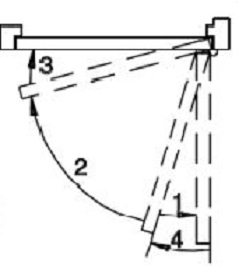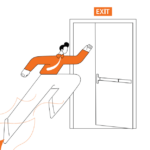Back in the early 90’s when the ADA was the newest focus of the door and hardware industry, delayed action closers were often specified and installed due to the assumption that they were required by the accessibility standards. Delayed action is a feature available on many door closers, which delays the closing cycle for up to a minute (or more depending on the manufacturer) from the maximum degree of opening to approximately 70 degrees. The delay is controlled by an additional valve which slows the flow of fluid for that initial period in the closing cycle. This feature can be helpful in some applications, but it is not required by code. The other segments of the closing cycle, the main speed and the latch speed, are also controlled by valves (see diagram below).
Although the codes and standards differ slightly regarding the exact closing speed requirements, they all state that the door must close slowly but they do not require a delay before the closing cycle begins:
- ICC/ANSI A117.1 – 2009: 90 degrees to 12 degrees – 5 seconds
- 2010 ADA/ABA Standards: 90 degrees to 12 degrees – 5 seconds
- MA 521 CMR: 90 degrees to closed – 6 seconds
Delayed action is a feature that may be useful for some interior doors, but the decision to use delayed action closers must be carefully considered. The assistance provided by the delay for some users may cause confusion for others. In many cases, having a door stand open for a minute will be a real inconvenience, and I’ve seen people attempt to manually close the door behind them. I typically reserve the use of delayed action closers to fire-rated storage rooms, and certain doors in health care facilities, like tub rooms. When this feature is supplied where it is not needed and maintenance staff learns that they can disable the delay, money has been spent for a feature that will never be used.
Some of the codes and standards also include a speed requirement for spring hinges. In my opinion, although spring hinges are not prohibited by the accessibility standards, they should not be used for doors that are required to be accessible. They don’t control the door, they only attempt to create enough momentum to get it closed and latched.
Here are the applicable excerpts from each of the standards:
ICC/ANSI A117.1 – 2009:
404.2.7 Closing Speed.
404.2.7.1 Door Closers. Door closers shall be adjusted so that from an open position of 90 degrees, the time required to move the door to an open position of 12 degrees shall be 5 seconds minimum.
404.2.7.2 Spring Hinges. Door spring hinges shall be adjusted so that from the open position of 70 degrees, the door shall move to the closed position in 1.5 seconds minimum.
2010 ADA/ABA Standards:
404.2.8 Closing Speed. Door and gate closing speed shall comply with 404.2.8.
404.2.8.1 Door Closers and Gate Closers. Door closers and gate closers shall be adjusted so that from an open position of 90 degrees, the time required to move the door to a position of 12 degrees from the latch is 5 seconds minimum.
404.2.8.2 Spring Hinges. Door and gate spring hinges shall be adjusted so that from the open position of 70 degrees, the door or gate shall move to the closed position in 1.5 seconds minimum.
MA 521CMR:
26.9 DOOR CLOSERS – If a door has a closer, then the sweep period of the closer shall be adjusted so that from an open position of 90 degrees, the door will take at least six seconds to close.
You need to login or register to bookmark/favorite this content.








Leave A Comment